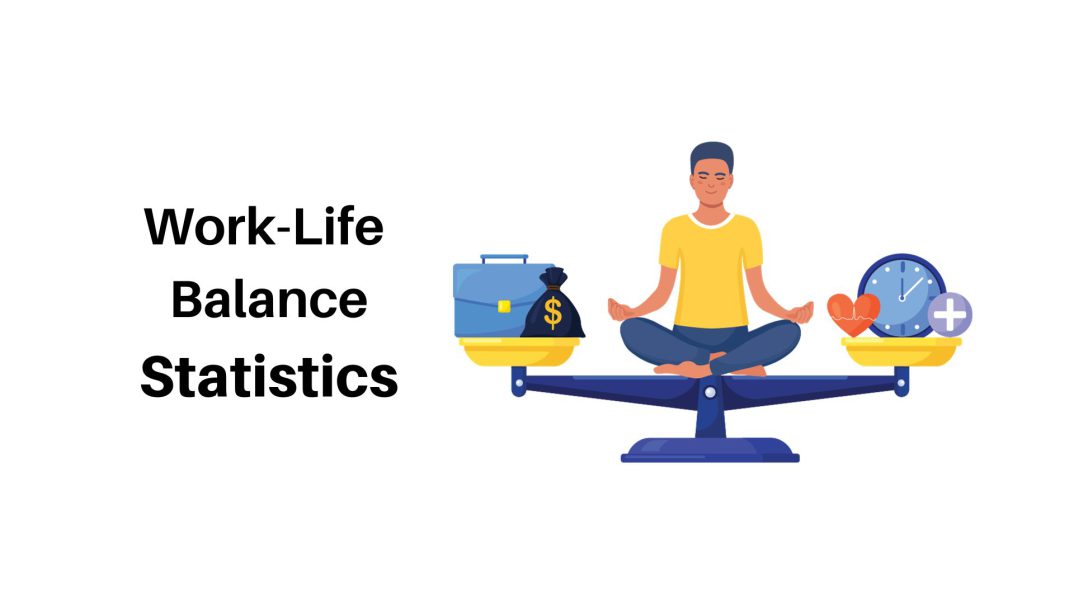Work-Life Balance Statistics By Facts, Importance, Burnout, Flexible vs. Non-Flexible and Barriers
August 13, 2024
—
Introduction
Work-Life Balance Statistics: These days work-life balance has become a tough thing to achieve it is not always possible for everyone across the world. Professional and personal life both is important factors for every individual, and if people aren’t able to balance out things properly then life becomes much more difficult to survive.
As of reports in 2022, around 89% of companies has promoted flexible work schedule for boosting employee retention with 41% of employees benefitting from many different wellness programs, 57% of employees are still suffering because of work-life balance.
These Work-Life Balance Statistics include many insights from various aspects that provide light on why work-life balance is an effective factor for both employees and companies today.
Editor’s Choice
- In the United States in 2022, employees did not have a proper work-life balance by 66%.
- Among other benefits, work-life balance is termed as the most important benefit by 1/3 of employees.
- Due to improper work-life balance approximately 51% of people have missed many important events in their life.
- In the U.S., average work on holidays, Saturdays, and Sundays was performed by 33% of adult employees by the end of 2022.
- In the 1st quarter of 2022, when people started working remotely the work-life balance of 67% of people improved.
- According to research, 76% of respondents said people preferred flexible work only for balancing out their work life.
- As of 2023, people by 72% always consider the factor of work-life balance when they are in the process of job searching.
- By the end of 2025, 75% of millennials are expected to cover the overall workforce.
Facts About Work-Life Balance
- Physical health and mental well-being were supported by employers believed by 78% of employees.
- Around 42% of companies in the world offer employees various wellness programs.
- 31% of employees preferred to pay up to 5% so that they could work from home for some time.
- 41% of employees preferred to pay cut up to 10% for enabling proper health and wellbeing facilities when required.
- 94% of United States professionals in 2022 almost spend more than 50 hours working per week.
- According to a survey with 1,000 respondents, almost 77% of American employees have experienced burnout in their jobs because of working full time.
- In 2022, flexible jobs have increased the work-life balance of about 79% of employees.
- Due to the heavy workforce and imbalanced work-life balance, around 80% of the baby boomers remained stressed across the world.
- 46% of Americans considered themselves workaholics in 2022.
- Due to the effects of burnout in organizations in 2022, organizations have spent around $190 billion to address different physical and psychological effects.
- In a week agricultural workers worked for 40.2 hours, and education employees worked around 39.3 hours.
Importance Of Work-Life Balance
- Employees with a work-life balance tend to have less burnout, and a healthy work-life balance work life includes more productive outcomes.
- A healthy work-life balance enables improving employees’ well-being and health condition so that they can manage heavy workloads in their organizations and family responsibilities together.
- It helps employees to spend more time on their hobbies and improves every aspect of life effectively.
- In 2022 companies that have provided work-life balance for employees are allowed to generate 2 times more productivity along with balancing out employees’ physical, emotional, and mental health and demands.
- There are six important elements of work-life balance self-management, time management, stress management, managing change, managing technology, and managing leisure time.
by U.S. Employees
(Reference: ctfassets.net)
General Work-Life Balance Statistics
- The importance of work-life balance stats in the United States is very important for 72% of people, somewhat important = 23%, not very important = 4%, and not important = 1%
- In 2022, due to a lack of flexibility and work-life balance around 34.3% that is above 1/3 of employees have quit their jobs.
- As of 2023, the Netherlands has maintained the best work-life balance with only 0.5% of long working hours.
- As of reports, 41% of Americans have considered themselves as workaholics.
- According to the reports of Smallbiz Trends, 66% of employees in their professional lives did not have a proper work-life balance.
- According to the reports of International Labor Organizations, American people worked approximately 50 hours in a week which is higher than other countries in 2022.
- In 2022 American employees worked 499 hours yearly more than French employees, 260 hours more than British employees, and 137 hours more than Japanese employees.
- American employees who didn’t feel work life was 83% of millennials and Gen Z.
- Over the world, around 6.66% of employees experienced work balance imbalance.
- 28% of employees started working before 8:30 AM and only 5% of employees started working before 7 AM.
- Work-life balance has been promoted by 23% of companies around the world at the end of 2022.
by Burnout
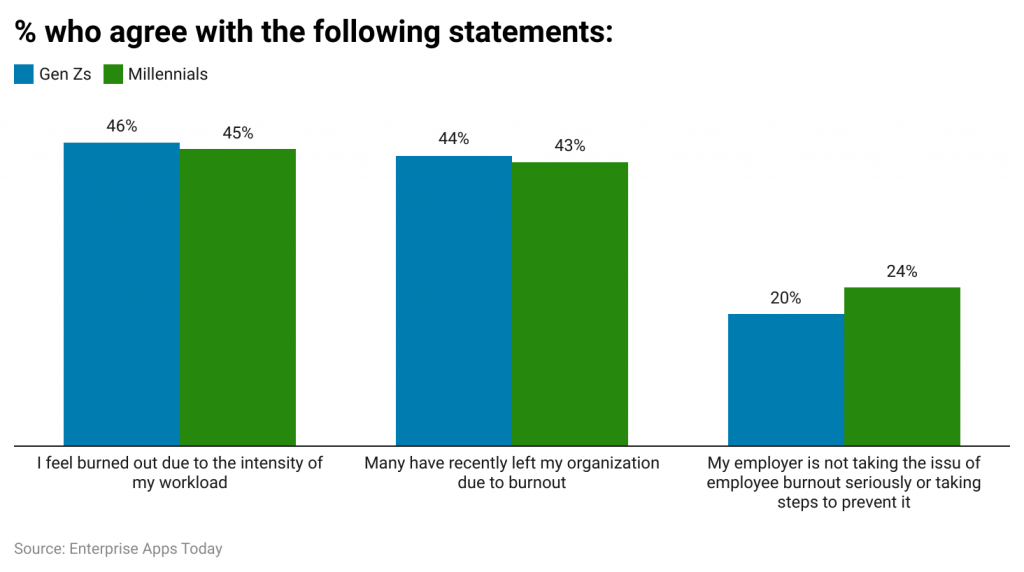 (Reference: elitecontentmarketer.com)
(Reference: elitecontentmarketer.com)
by Flexible vs. Non-Flexible Working
- Work-life balance: with flexible job option = 54%, without flexible job option = 29%
- Stressed by their level of work-life balance: with flexible job option = 21%, without flexible job option = 43%
- Percentage of those whose boss’s work habits make work-life balance easy for employees: with flexible job option = 35%, without flexible job option = 14%
- Percentage of those whose boss’s work-life balance is difficult for employees: with flexible job option = 27%, without flexible job option = 40%
by Barriers
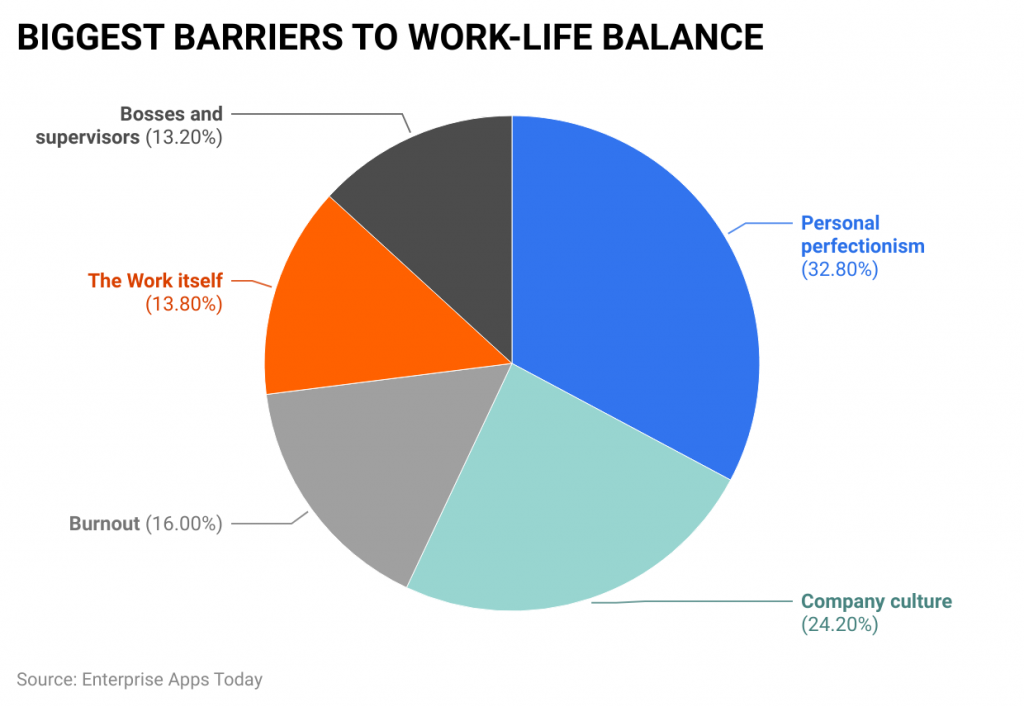 (Reference: zippia.com)
(Reference: zippia.com)
- Personal perfectionism = 32.80%
- Company culture disturbance = 24.20%
- Burnout = 16%
- The work pressure itself = 13.80%
- Supervisors and bosses pressure = 13.20%
by Challenges
- Lack of support and recognition for employees by the company’s leaders was termed as the biggest burnout of work-life balance which has been agreed by 31% of employees.
- Deadlines and unrealistic expectations = 30% of employees
- Long hours of working or working on weekends = 29%
Reasons Statistics For Not Having a Work-Life Balance
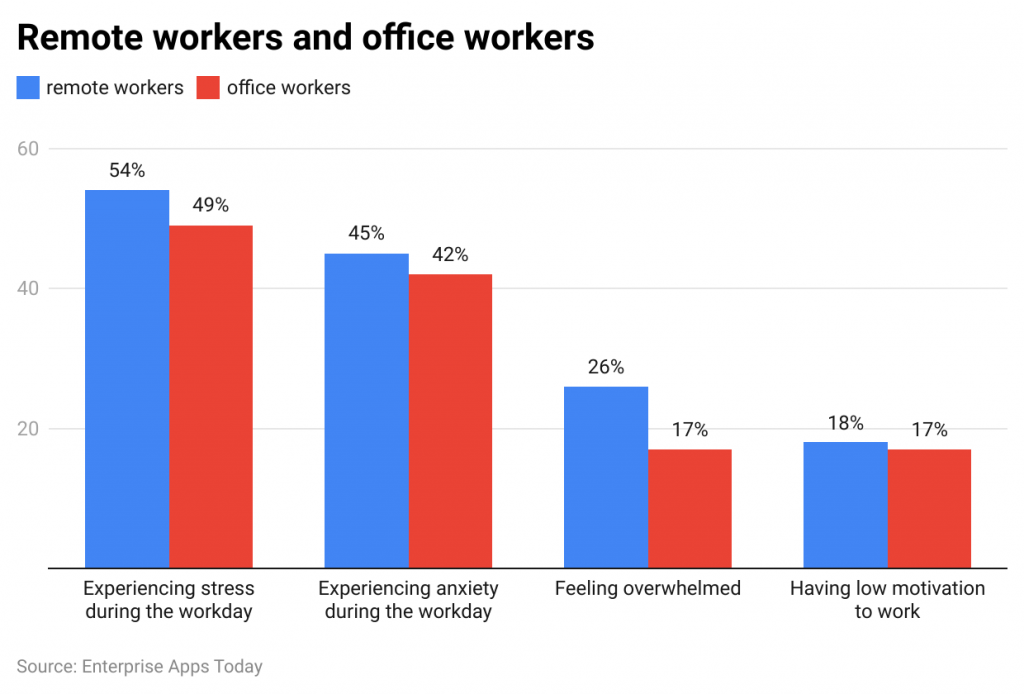 (Reference: clockify. me)
(Reference: clockify. me)
- In the United States, 2022 there are 29% of remote employees and 23% of office workers. The above graph describes the possible reasons for the work-life imbalance between remote and on-site workers.
- Experiencing stress during working hours: remote worker = 54%, and on-site workers = 49%
- Experiencing anxiety: remote worker = 45%, and on-site workers = 42%
- Feeling overwhelmed: remote worker = 26%, and on-site workers = 17%
- Having low motivation to work: remote worker = 18%, and on-site workers = 17%
Best Work-life Balance Statistics by Best Country
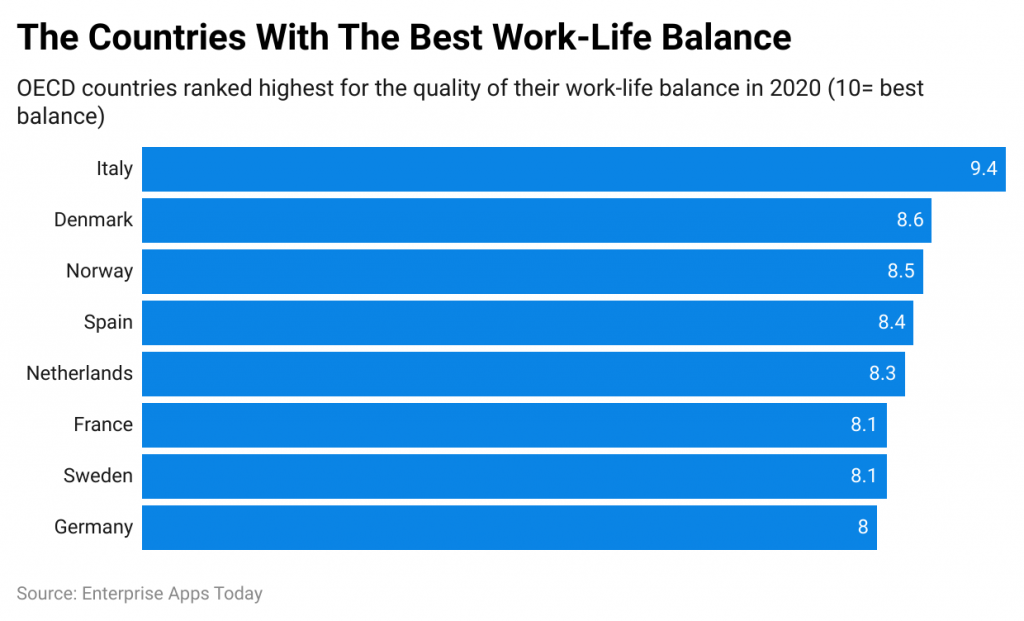 (Reference: elitecontentmarketer.com)
(Reference: elitecontentmarketer.com)
- Over the world in 2022, the best work-life balance was achieved by Italy with a score of 9.4 out of 10, Denmark = 8.6, Norway = 8.5, Spain = 8.3, France = 8.1, Sweden = 8.1, Germany = 8.0, Costa Rica = 1.3, Mexico = 0.4, and Colombia = 0.6
Across the World by Generation
- Baby Boomers: Realistic = 77.1%, Neither realistic nor unrealistic = 3.8%, and Unrealistic = 19.1%
- Generation X: Realistic = 70.8%, Neither realistic nor unrealistic = 2.8%, and Unrealistic = 26.5%
- Millennial: Realistic = 67.5%, Neither realistic nor unrealistic = 5.9%, and Unrealistic = 26.6%
In the U.S. by Generation
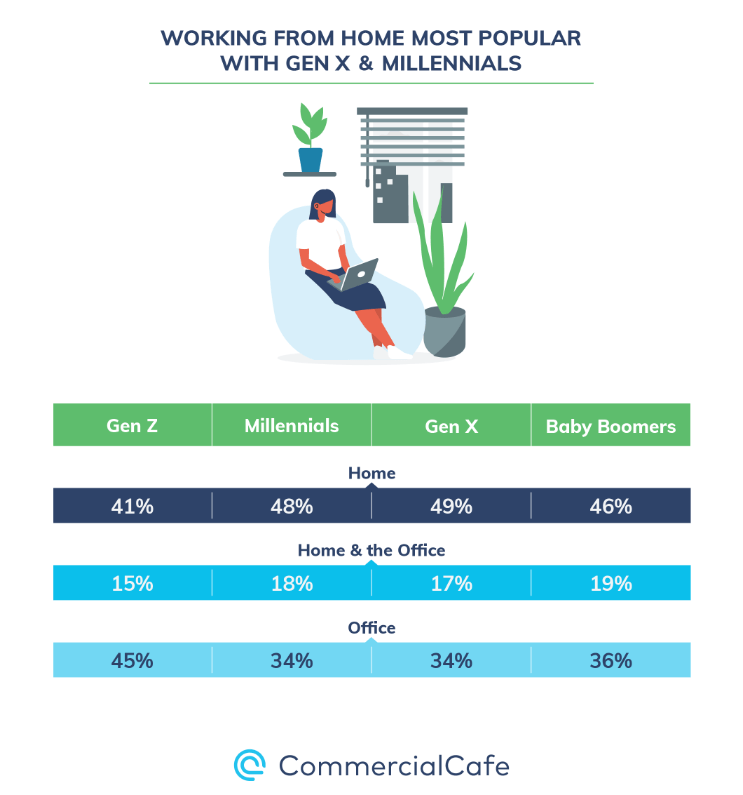 (Source: point2homes.com)
(Source: point2homes.com)
- In the United States in 2022, work-from-home workers have earned better work-life balance i.e., Gen Z = 41%, Millennials = 48%, Gen X = 49%, and Baby Boomers = 46%
- Hybrid workers: Gen Z = 15%, Millennial = 18%, Gen X = 17%, and Baby Boomers = 19%
- On-site or office workers: Gen Z = 45%, Millennial = 34%, Gen X = 34%, and Baby Boomers = 36%
- Satisfied with their work-life balance: Gen Z = 50%, Millennial = 61%, Gen X = 63%, and Baby Boomers = 77%
- Dissatisfied with their work-life balance: Gen Z = 25%, Millennial = 20%, Gen X = 20%, and Baby Boomers = 12%
by Country
- The Netherlands experienced the best work-life balance in 2023; employees by only 0.4% worked for long hours.
- In 2022, the best countries for work-life balance are Luxembourg, Finland, Norway, Iceland, Netherlands, Sweden, Spain, Austria, Estonia, and Germany.
- In Turkey, almost 1/3 of employees work so hard every week that is around 50 hours.
- In Colombia, more than 25.5% of employees have worked for more long hours by the end of 2022.
- By the end of 2022, employees experienced overworked in South Korea by 25.2%
- In Mexico, people spend around 12.4 hours on different leisure activities such as sleeping, and employees by 28.7% have worked long hours, which has imbalanced their work life.
- Mexican employees by 27% worked more than 50 hours a week.
- Southern Asian regions worked 49 hours per week on average employees.
- In 2022, American by 63% have chosen better work-life flexibility rather than salary increments, and 83% claimed remote or hybrid jobs for enhancing their work-life balance.
- In the United States, people spend 14.4 hours on leisure activities which is about 60% of the day, whereas around the world people spend almost 25 hours on leisure activities and sleep which is about 67% of the day.
- Across the world, 22% of employees haven’t tried any measures to improve their work-life balance.
by Gender Difference
- Men (non-parents): Realistic = 74.9%, Neither realistic nor unrealistic = 4.4%, and Unrealistic = 20.7%
- Women (non-parents): Realistic = 69.4%, Neither realistic nor unrealistic = 4.7%, and Unrealistic = 25.9%
- Men (parents): Realistic = 70.7%, Neither realistic nor unrealistic = 3.1%, and Unrealistic = 26.2%
- Women (parents): Realistic = 69%, Neither realistic nor unrealistic = 4.7%, and Unrealistic = 26.4%
- Across the world in 2022, male employees by 14% can work for longer time as compared to 6% of women.
- According to Statista, 78% of females and 67% of males preferred the work-life balance more important.
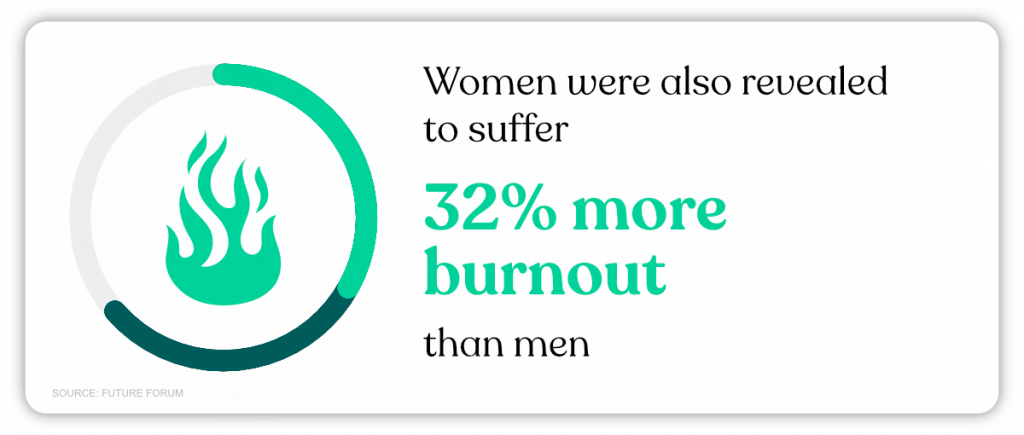 (Source: ctfassets.net)
(Source: ctfassets.net)
By Wealth, Happiness, and Healthiest Among Countries
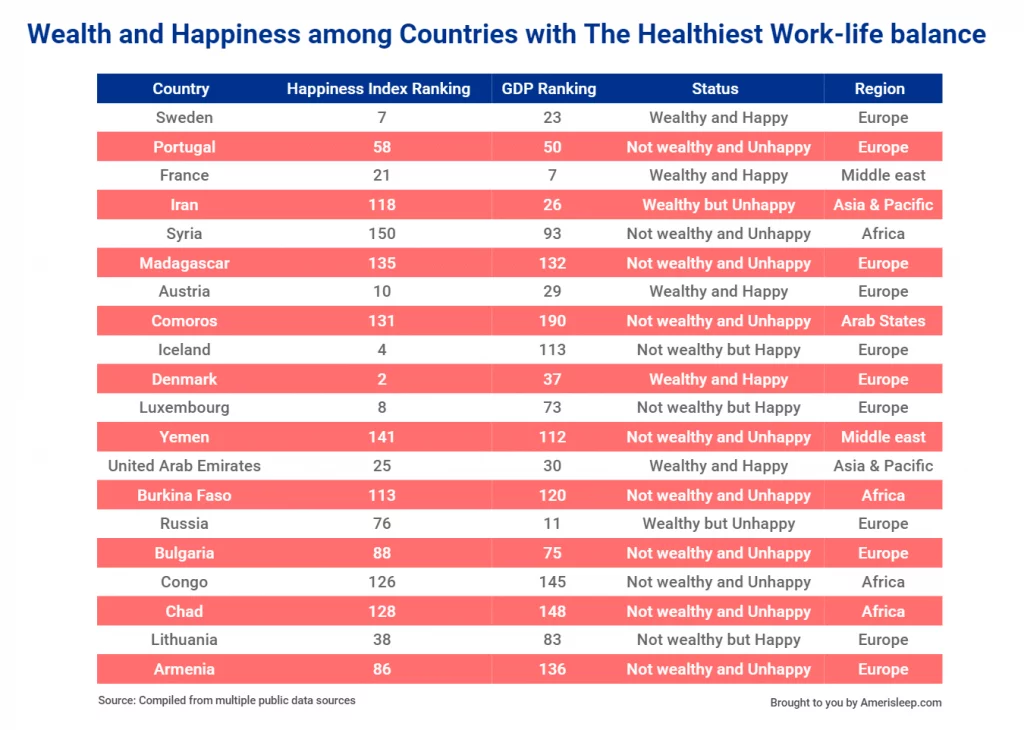 (Source: amerisleep.com)
(Source: amerisleep.com)
Least Working Hours Statistics by Countries
- Germany = 1349 hours/year
- Denmark = 1363 hours/year
- Luxembourg = 1382 hours/year
- Netherlands = 1417 hours/year
- Norway = 1427 hours/year
- Iceland = 1433 hours/year
- Austria = 1442 hours/year
- Sweden = 1444 hours/year
- France = 1490 hours/year
- Belgium = 1493 hours/year
U.S. Adult’s Statistics by work-life Balance
- Work-life balance is an important aspect that has been accepted by 88% of employees.
- Over consistent work hours, 88% of employees preferred work-life balance in 2022.
- 86% of employees preferred work-life balance over easy commute.
- In the case of choosing an employer around 57% of people prioritized good and healthy work-life balance.
- For improving the work-life balance of employees 83% of American employees preferred working for 4 days a week.
- Work-life balance helped in improving 79% mental health, and 78% more productive.
- As of 2022, American managers didn’t encourage and motivate employees when they needed the most to take time off agreed to 58% of respondents, whereas 42% of employees said managers have actively encouraged employees.
- According to the statistics of PTO, there were no paid-offs available for 31% of U.S. workers.
Conclusion
As of now, after completing the article on Work-Life Balance Statistics, it can be stated that the work-life balance is essential for both companies and employees. This also allows for boosting employee retention by enabling healthy well-being and enhanced productivity across the world and the United States.
Better work-life balance helps reduce employees’ stress, enhance job satisfaction, and along with retaining top talents for companies. As of reports in the U.S. 72% of employees preferred work-life balance against any other factors. Thus, the article includes several other important statistics that will help better understand the topic.
[3px] border-t-[3px] p-4 border-[#1d598f] my-4″ style=”box-shadow: 0 0 14px rgb(9 38 66 / 8%);”>
Sources
How to improve work life balance?
Work life balance can be improved by setting and sticking to clear boundaries that depends on the type of job. Mostly communication with managers or leaders or boss is an important requirement for employees in their need.
What are the causes of poor work life balance?
The main causes of poor work life balance are personal perfectionism, disturbances within different companies culture, burnout factor, work pressure, and supervisors and bosses pressure.
What are the benefits of work life balance?
The work life benefit includes better employee retention and acquisition, allows in increasing employee morale, promotes healthy life, and productivity increment.
Work-Life Balance Statistics By Facts, Importance, Burnout, Flexible vs. Non-Flexible and Barriers
Data is from 2023 and 2024 and forecast data is for 2025 and 2026. We also expand the forecast data to 2027 and 2028.
——
REFERENCES:
This information was taken from various sources around the world, including these countries:
Australia, Canada, USA, UK, UAE, India, Pakistan, Philippines, Indonesia, Nigeria, Tanzania, Kenya, US, United Kingdom, United States of America, Malaysia, U.S., South Africa, New Zealand, Turkey, United Arab Emirates.
Afghanistan, Albania, Algeria, American Samoa, Andorra, Angola, Anguilla, Antarctica, Antigua and Barbuda, Argentina, Armenia, Aruba, Australia, Austria, Azerbaijan.
Bahamas, Bahrain, Bangladesh, Barbados, Belarus, Belgium, Belize, Benin, Bermuda, Bhutan, Bolivia, Bosnia and Herzegovina, Botswana, Bouvet Island, Brazil, British Indian Ocean Territory, Brunei Darussalam, Bulgaria, Burkina Faso, Burundi.
Cambodia, Cameroon, Canada, Cape Verde, Cayman Islands, Central African Republic, Chad, Chile, China, Christmas Island, Cocos (Keeling Islands), Colombia, Comoros, Congo, Cook Islands, Costa Rica, Cote D’Ivoire (Ivory Coast), Croatia (Hrvatska), Cuba, Cyprus, Czech Republic.
Denmark, Djibouti, Dominica, Dominican Republic, East Timor, Ecuador, Egypt, El Salvador, Equatorial Guinea, Eritrea, Estonia, Ethiopia, Falkland Islands (Malvinas), Faroe Islands, Fiji, Finland, France, Metropolitan, French Guiana, French Polynesia, French Southern Territories.
Gabon, Gambia, Georgia, Germany, Ghana, Gibraltar, Greece, Greenland, Grenada, Guadeloupe, Guam, Guatemala, Guinea, Guinea-Bissau, Guyana, Haiti, Heard and McDonald Islands, Honduras, Hong Kong, Hungary, Iceland, India, Indonesia, Iran, Iraq, Ireland, Israel, Italy.
Jamaica, Japan, Jordan, Kazakhstan, Kenya, Kiribati, North Korea, South Korea, Kuwait, Kyrgyzstan, Laos, Latvia, Lebanon, Lesotho, Liberia, Libya, Liechtenstein, Lithuania, Luxembourg.
Macau, Macedonia, Madagascar, Malawi, Malaysia, Maldives, Mali, Malta, Marshall Islands, Martinique, Mauritania, Mauritius, Mayotte, Mexico, Micronesia, Moldova, Monaco, Mongolia, Montserrat, Morocco, Mozambique, Myanmar.
Namibia, Nauru, Nepal, Netherlands, Netherlands Antilles, New Caledonia, New Zealand (NZ), Nicaragua, Niger, Nigeria, Niue, Norfolk Island, Northern Mariana Islands, Norway.
Oman, Pakistan, Palau, Panama, Papua New Guinea, Paraguay, Peru, Philippines, Pitcairn, Poland, Portugal, Puerto Rico, Qatar, Reunion, Romania, Russia, Rwanda, Saint Kitts and Nevis, Saint Lucia, Saint Vincent and The Grenadines, Samoa, San Marino, Sao Tome and Principe.
Saudi Arabia, Senegal, Serbia, Seychelles, Sierra Leone, Singapore, Slovakia, Slovenia, Solomon Islands, Somalia, South Africa, South Georgia and South Sandwich Islands, Spain, Sri Lanka, St. Helena, St. Pierre and Miquelon, Sudan, Suriname, Svalbard and Jan Mayen Islands, Swaziland, Sweden, Switzerland, Syria.
Taiwan, Tajikistan, Tanzania, Thailand, Togo, Tokelau, Tonga, Trinidad and Tobago, Tunisia, Turkey, Turkmenistan, Turks and Caicos Islands, Tuvalu, Uganda, Ukraine, United Arab Emirates (UAE), UK (United Kingdom), USA (United States of America, U.S.), US Minor Outlying Islands.
Uruguay, Uzbekistan, Vanuatu, Vatican City State (Holy See), Venezuela, Vietnam, Virgin Islands (British), Virgin Islands (US), Wallis and Futuna Islands, Western Sahara, Yemen, Yugoslavia, Zaire, Zambia, Zimbabwe.
Work-Life Balance Statistics By Facts, Importance, Burnout, Flexible vs. Non-Flexible and Barriers
August 13, 2024

